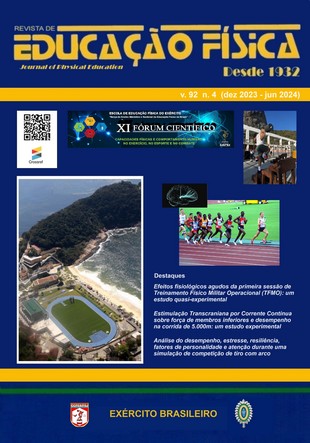Abstract
Introduction: The Operational Military Physical Training (OMPT) sessions consist of exercises designed to develop the physical state of operational readiness of the troops of the Brazilian Army Readiness Force.
Objective: To examine the physiological effects of a OMPT session on heart rate (HR) and blood lactate.
Methods: This was a quasi-experimental study, with a convenience sample, in which 15 soldiers from a military unit in Rio de Janeiro (Estácio de Sá Battery) were invited to participate. Blood lactate was collected before and after the session, and HR was measured in the neuromuscular and operational task phases. The Shapiro-Wilk test was applied to assess the normality of data distribution. To evaluate the differences between the pre- and post-intervention measures, the paired and unpaired Student's t-test was used.
Results: A total of 15 military personnel participated in the study. The pre- and post- OMPT lactate values were significantly different (p=0.024), and the pre- lactate (mean of 2.58±0.27 mmol/L) was lower than the post-lactate (mean of 3.93±1.22 mmol/L). There was a significant difference in the comparison of the mean HR in the circuit neuromuscular phase with the operational task phase (p<0.001), and the mean HR in the neuromuscular phase was lower than in the operational task phase.
Conclusion: The first session of operational military physical training generated physiological changes in the military in relation to lactate concentration and heart rate. The results were discussed.
References
Santtila M, Kyröläinen H, Vasankari T, Tiainen S, Palvalin K, Häkkinen A, et al. Physical Fitness Profiles in Young Finnish Men during the Years 1975-2004. Medicine & Science in Sports & Exercise. 2006;38(11): 1990–1994. https://doi.org/10.1249/01.mss.0000232023.28984.78.
Knapik JJ, Sharp MA, Steelman RA. Secular Trends in the Physical Fitness of United States Army Recruits on Entry to Service, 1975–2013. Journal of Strength and Conditioning Research. 2017;31(7): 2030–2052. https://doi.org/10.1519/JSC.0000000000001928.
Sharp. A Database of Physically Demanding Tasks Performed by U.S. Army Soldiers. https://apps.dtic.mil/sti/citations/ADA338922
Hauschild VD, DeGroot DW, Hall SM, Grier TL, Deaver KD, Hauret KG, et al. Fitness tests and occupational tasks of military interest: a systematic review of correlations. Occupational and Environmental Medicine. 2017;74(2): 144–153. https://doi.org/10.1136/oemed-2016-103684.
Kyröläinen H, Pihlainen K, Vaara JP, Ojanen T, Santtila M. Optimising training adaptations and performance in military environment. Journal of Science and Medicine in Sport. 2018;21(11): 1131–1138. https://doi.org/10.1016/j.jsams.2017.11.019.
Instituto de Pesquisa da Capacitação Física do Exército. Teste Físico Operacional (TFO). Revista de Educação Física / Journal of Physical Education. 2021;90(2): S6–S7.
Friedl KE, Knapik JJ, Häkkinen K, Baumgartner N, Groeller H, Taylor NAS, et al. Perspectives on Aerobic and Strength Influences on Military Physical Readiness: Report of an International Military Physiology Roundtable. Journal of Strength and Conditioning Research. 2015;29(Supplement 11): S10–S23. https://doi.org/10.1519/JSC.0000000000001025.
Gibala MJ, Gagnon PJ, Nindl BC. Military Applicability of Interval Training for Health and Performance. Journal of Strength and Conditioning Research. 2015;29(Supplement 11): S40–S45. https://doi.org/10.1519/JSC.0000000000001119.
Gist NH, Freese EC, Ryan TE, Cureton KJ. Effects of Low-Volume, High-Intensity Whole-Body Calisthenics on Army ROTC Cadets. Military Medicine. 2015;180(5): 492–498. https://doi.org/10.7205/MILMED-D-14-00277.
Marín-Pagán C, Blazevich AJ, Chung LH, Romero-Arenas S, Freitas TT, Alcaraz PE. Acute Physiological Responses to High-Intensity Resistance Circuit Training vs. Traditional Strength Training in Soccer Players. Biology. 2020;9(11): 383. https://doi.org/10.3390/biology9110383.
Márquez G, Romero‐Arenas S, Marín‐Pagán C, Vera‐Ibañez A, FernáNdez Del Olmo M, Taube W. Peripheral and central fatigue after high intensity resistance circuit training. Muscle & Nerve. 2017;56(1): 152–159. https://doi.org/10.1002/mus.25460.
Dougherty JJ. The anatomical “core”: a definition and functional classification. Osteopathic Family Physician. 2011;3(6): 239–245. https://doi.org/10.1016/j.osfp.2011.07.001.
Aquino PAA. Exercício físico para promoção da saúde durante o período gestacional: recomendações e cuidados. [Dissertação de Mestrado Profissional] [Londrina]: Unopar; 2023. https://repositorio.pgsscogna.com.br/bitstream/123456789/58550/1/Produto%20Tecnico%20Defesa%20Pos%20Banca.pdf [Accessed 27th May 2024].
Fidje Sports Equipment. Quais são as diferenças entre um Slam Ball, Wall Ball e Medicine Ball? - Fidje. https://www.fidje.com.br/quais-sao-as-diferencas-entre-um-slam-ball-wall-ball-e-medicine-ball/ [Accessed 25th April 2024].
Brito A., Fernandes R. , Carvalho H. , Brito J., Muñoz A., Soto A., & Miarka B. Acute effect of high-intensity functional training (HIFT) using a benchmark on cognition and physiological parameters according to the competitive level. Journal of Physical Education and Sport. 23(6):1432-1440. https://doi.org/10.7752/jpes.2023.06175.
Tibana RA, Manuel Frade De Sousa N, Prestes J, Da Cunha Nascimento D, Ernesto C, Falk Neto J, et al. Is Perceived Exertion a Useful Indicator of the Metabolic and Cardiovascular Responses to a Metabolic Conditioning Session of Functional Fitness? Sports. 2019;7(7): 161. https://doi.org/10.3390/sports7070161.
Tibana R, De Sousa N, Prestes J, Voltarelli F. Lactate, Heart Rate and Rating of Perceived Exertion Responses to Shorter and Longer Duration CrossFit® Training Sessions. Journal of Functional Morphology and Kinesiology. 2018;3(4): 60. https://doi.org/10.3390/jfmk3040060.
Santos DAT, Morais NS, Viana RB, Costa GCT, Andrade MS, Vancini RL, et al. Comparison of physiological and psychobiological acute responses between high intensity functional training and high intensity continuous training. Sports Medicine and Health Science. 2023; https://doi.org/10.1016/j.smhs.2023.10.006.
de Diego-Moreno M, Álvarez-Salvago F, Martínez-Amat A, Boquete-Pumar C, Orihuela-Espejo A, Aibar-Almazán A, et al. Acute Effects of High-Intensity Functional Training and Moderate-Intensity Continuous Training on Cognitive Functions in Young Adults. International Journal of Environmental Research and Public Health. 2022;19(17): 10608. https://doi.org/10.3390/ijerph191710608.
McArdle WD, Katch FI, Katch VL. Fisiologia do Exercício. Nutrição, Energia e Desempenho Humano.. 7a edição. Rio de Janeiro: Guanabara Koogan; 2011.
Almeida MB de. Heart rate and exercise: An evidence-based interpretation. Revista Brasileira de Cineantropometria e Desempenho Humano. 2007;9(2): 196–202. https://doi.org/10.1590/%x.
Burke ER, [ed.]. Precision Heart Rate Training.. 1st edition. Champaign, Il: Human Kinetics; 1998.
Moreno MR, Rodas KA, Bloodgood AM, Dawes JJ, Dulla JM, Orr RM, et al. The Influence of Aerobic Fitness on Heart Rate Responses of Custody Assistant Recruits during Circuit Training Sessions. International Journal of Environmental Research and Public Health. 2020;17(21): 8177. https://doi.org/10.3390/ijerph17218177.
Mainenti M, Oliveira L, Godinho S. Treinamento físico do militar combatente: discutindo funcionalidade e especificidade. In: Celestino S, Cunha R. Ciência para a saúde, a operacionalidade e o desporto militar. Curitiba: Editora CRV, 2023. p.147-164.

This work is licensed under a Creative Commons Attribution 4.0 International License.
Copyright (c) 2024 Journal of Physical Education
